Mercedes Benz Malaysia proudly introduces its second model series to be based on the electric architecture which developed specifically for electric vehicles, the new EQE 350+ by Mercedes EQ. The business saloon EQE 350+ based on the electric architecture for large vehicles EVA 2, similar to EQS 450+ offers all the essential functions of the EQS in a slightly more compact format.
Sagree Sardien, CEO & President of Mercedes-Benz Malaysia says, “2022 is an extremely important year in our electric initiative: with the introduction of the EQA, EQB, EQC, EQS and now EQE, we have the most comprehensive electric-vehicle portfolio here in Malaysia.
She added, “The Mercedes-EQ brand is pursuing a goal that is ambitious as it is clear: that we’ll build the most sustainable and most technically advanced cars in the world. By bringing responsible innovation to the road, we’re driving change. The EQE is the latest example of this – and it will make a powerful contribution towards the future of mobility.”
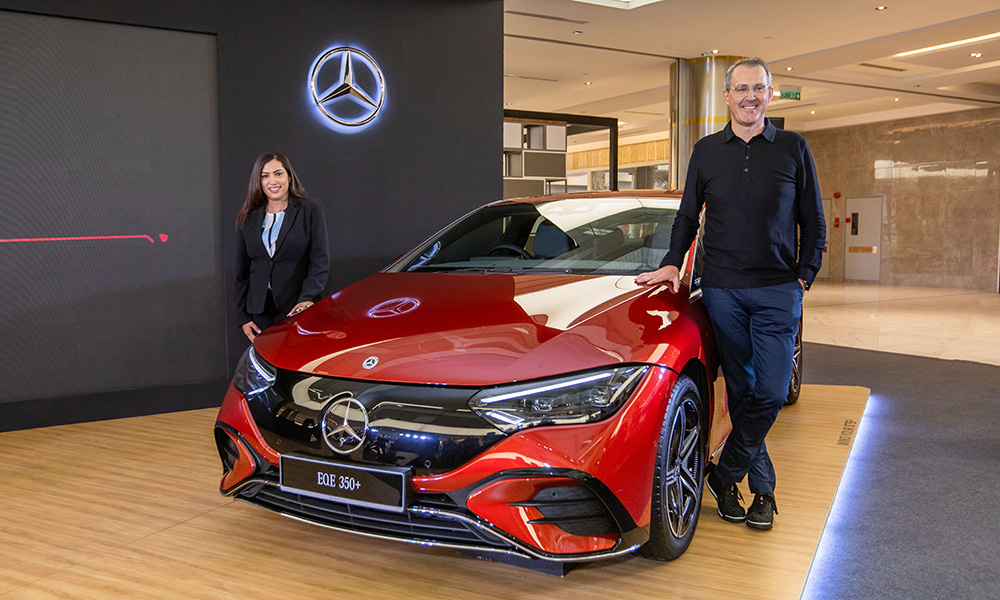
Michael Jopp, Vice President of Sales & Marketing, Mercedes-Benz Malaysia added, “After the EQS, the EQE is already the second model on our new platform for luxury segment. The EQE is the next all-purpose electric luxury sedan with the typical One-Bow-Signature Design creating fast lines and silhouette and through that a very aerodynamic and futuristic look. All of this makes the car more flamboyant and entertaining, more extraordinary and defines the next level of luxury for the Mercedes-EQ brand.
With its dynamic driving experience and comprehensive range of Connected Services, the EQE is a perfect fit for the desires of a modern generation of customers. We reconcile innovation and emotionality with sustainability and we are actively contributing to the reduction of CO2 emissions.”
The EQE has a slightly shorter wheelbase compared to the EQS with shorter overhangs and more recessed flanks – it carries the concept of the business saloon into the future. Sensual Purity is reflected in generously modelled surfaces, reduced joints and seamless transitions (seamless design). The overhangs and the front end are kept short, the rear provides the dynamic accent with a sharp rear spoiler. Flush with the outer edge of the body, the 19-inch AMG light-alloy wheels, together with a pronounced muscular shoulder section, give the EQE an athletic character.
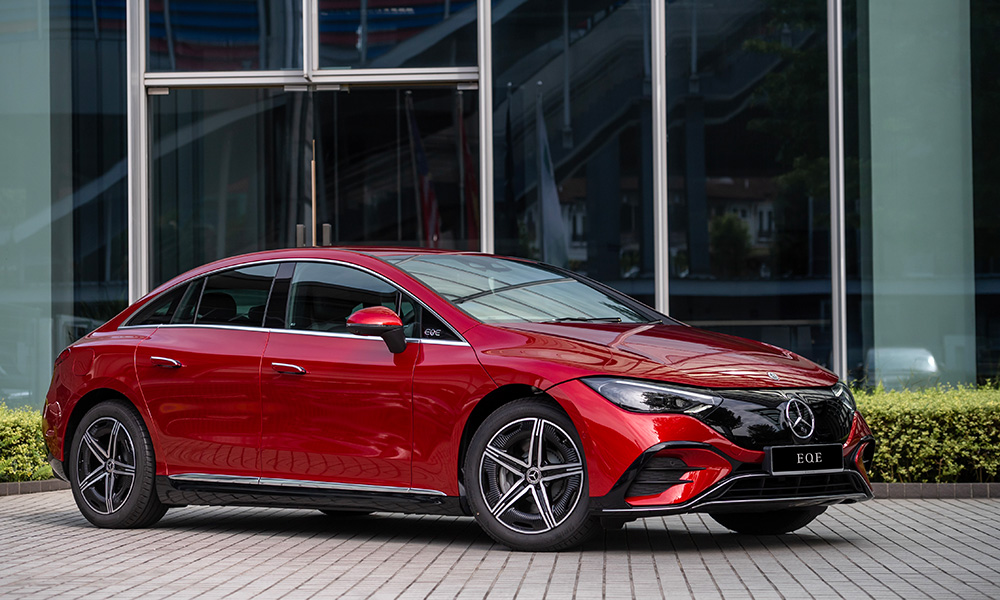
Efficient drive system with range of up to 669 kilometres
The battery in the EQE has a usable energy content of 90.56 kWh, and the range of up to 669 km1 according to WLTP is absolutely suitable for travelling.
All EQE models have an electric drivetrain (eATS) on the rear axle. The electric motors are permanently excited synchronous motors (PSM). With the PSM, the rotor of the AC motor is fitted with permanent magnets and therefore does not need to be supplied with power. The advantages of this design include high power density, high efficiency and high power constancy. The motor on the rear axle is particularly powerful due to its six-phase design: it has two windings with three phases each.
In the EQE, the lithium-ion battery consists of ten modules and has a usable energy content of 90.56 kWh. The innovative battery management software, developed in-house, allows updates over the air (OTA). In this way, the energy management of the EQE remains up-to-date throughout the life cycle.
In the case of the battery, a major step has been achieved in terms of the sustainability of the cell chemistry: the optimised active material consists of nickel, cobalt and manganese in a ratio of 8:1:1. This reduces the cobalt content to less than ten percent. The continuous optimisation of recyclability is part of Mercedes-Benz’s holistic battery strategy.
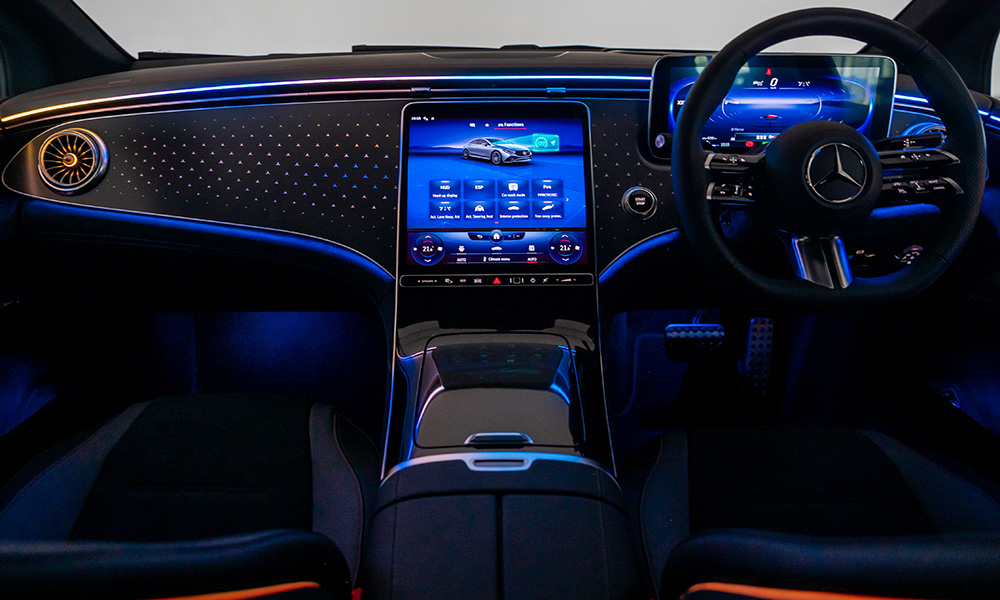
Unconventional interior design and high operating convenience
The vent band spans across the entire width at the top and is very slim at the same time. These extreme proportions, create the avant-garde architecture of the cockpit. The outer nozzles feature a turbine design. They play on the theme hyperanalogue through the contrast between high-tech precision mechanics and digital, glass display world.
The latest MBUX generation, recently introduced in the EQS, is also on board the EQE. With adaptive software, the control and display concept completely adapts to its user and makes personalised suggestions for numerous infotainment, comfort and vehicle functions. With the zero-layer design, the user does not have to scroll through submenus or give voice commands. The most important applications are offered situationally and contextually on the top level in the field of view. In this way the EQE driver is relieved of certain operating steps.
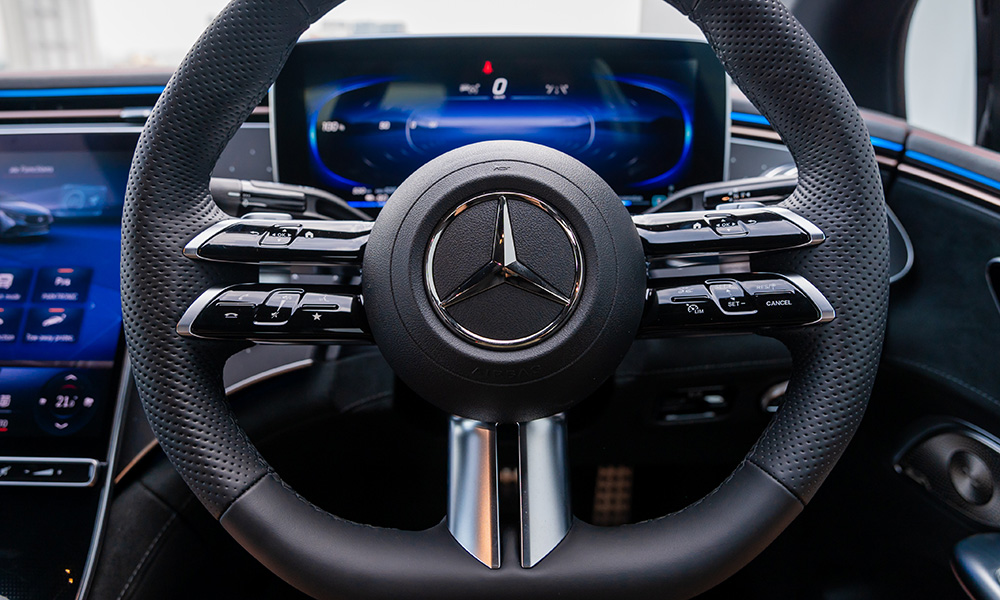
Consistently high performance and multiple accelerations without a drop in power characterise the EQE’s drive philosophy. This includes a sophisticated thermal concept and several variants of energy recovery by means of recuperation in this process, the high-voltage battery is charged by converting the mechanical rotary motion into electrical energy during overrun or braking mode. The driver can manually select the deceleration in three stages (D+, D, D–) as well as the gliding function via shift paddles behind the steering wheel. Also available: DAuto. ECO Assist also offers situation-optimised recuperation – deceleration is so strong or weak that it ultimately results in the most efficient driving style. If possible, recuperative deceleration is also used for vehicles detected ahead. This even occurs until they come to a standstill, for example at traffic lights. The driver does not need to press the brake pedal for this – literally one-pedal driving.
Navigation with Electric Intelligence plans the fastest and most convenient route, based on numerous factors and reacts dynamically to traffic jams or a change in driving style, for example. This includes a visualisation in the MBUX infotainment system as to whether the available battery capacity is sufficient to return to the starting point without charging.
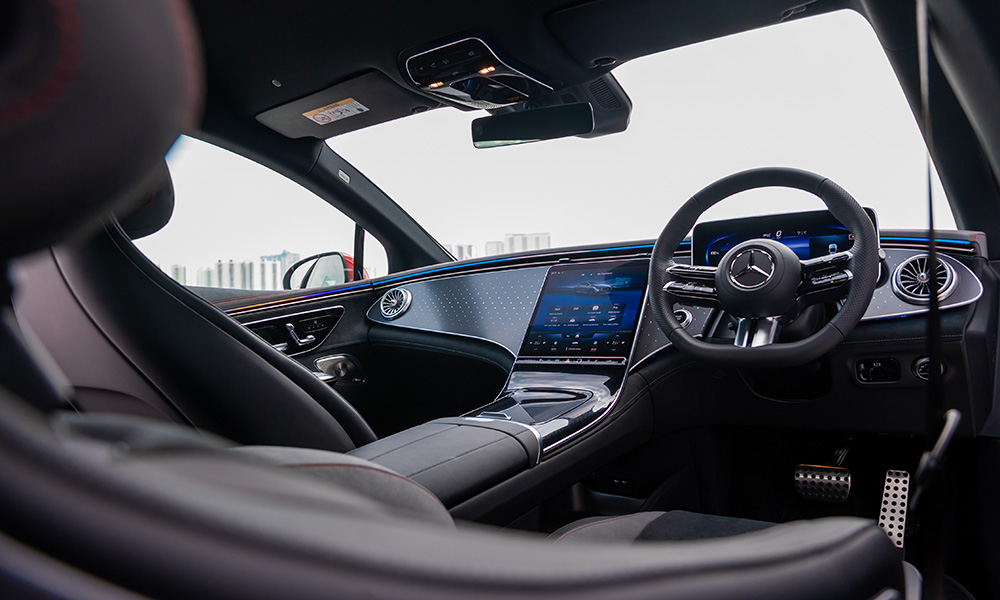
High noise and vibration comfort, Sound Experiences as a contrast
As a saloon with a boot lid, the EQE’s concept is well equipped to offer a high level of NVH comfort Noise, Vibration, Harshness) into account. Numerous measures contribute to this. In the electric drivetrains (eATS), the magnets are arranged inside the rotors in an NVH-optimised way (known as ‘sheet metal cut’). In addition, the eATS have a special foam mat all around as an NVH cover. The inverter cover is a sandwich construction. The eATS are double-decoupled from the body via elastomeric bearings.
Highly effective spring/mass components provide continuous sound insulation from the crossmember under the windscreen to the floor of the boot. Acoustic foams are inserted into many carriers during body-in-white construction.
With the Burmester® surround sound system on board, the EQE has the two soundscapes: Silver Waves Vivid Flux and Roaring Pulse. Silver Waves is a sensuous and clean sound. Aimed at EV enthusiasts, Vivid Flux is crystalline, synthetic yet humanly warm. They can be selected or switched off as sound experiences on the central display. The e Roaring Pulse sound experience is reminiscent of powerful machines, and is sonorous and extroverted.
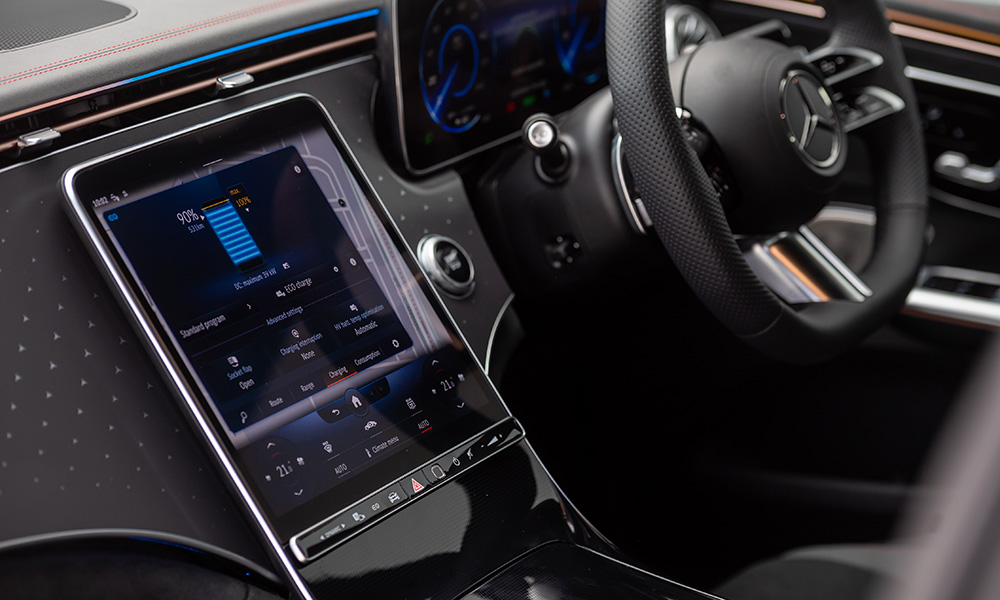
High level of passive and active safety
The principles of Integral Safety, in particular accident safety, apply regardless of the platform. Like all other Mercedes-Benz models, the EQE therefore has a rigid passenger cell, special deformation zones and modern restraint systems with PRE-SAFE®.
Available as standard, the EQE is equipped with the Driving Assistance Plus package that includes but not limited to Active Distance DISTRONIC, Active Stop-and Go Assist, Active Steering Assist with Hands-off warning and Active Lane Keeping Assist. These numerous assistance systems support the driver as the situation requires, warning the driver if there is a risk of collision and intervening if necessary – for the benefit of all road users
The fact that the EQE is based on an all-electric architecture also opened up new design possibilities for its safety concept. It meant, for example, that a favourable location could be chosen for the installation of the battery, in a crash-protected area in the underbody. And because there is no large crankcase on board, the behaviour in a frontal crash could be modelled even better.
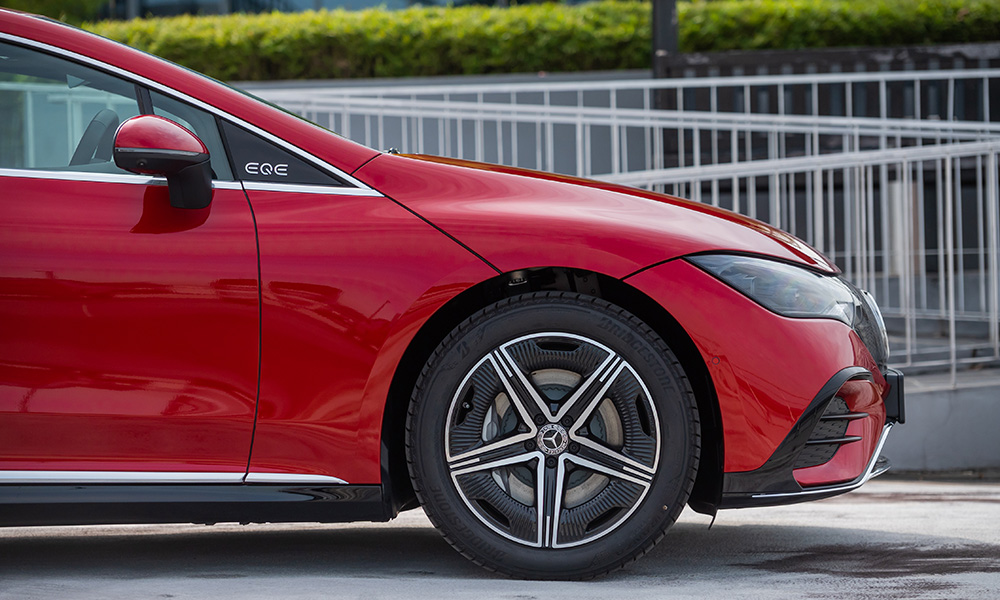
Accelerated transformation from “Electric first” to “Electric only”
The new EQE: sustainability
Mercedes-Benz is setting the course for an all-electric future: by the end of the decade, the brand with the star will be ready to go fully electric – wherever market conditions permit. With this strategic step from “Electric first” to “Electric only”, Mercedes-Benz is accelerating its transformation into an emission-free and software-driven future. In many areas, Mercedes is already thinking about tomorrow today: the new EQE is designed to be correspondingly sustainable. Resource-saving materials such as secondary steel are also used. Mercedes-Benz looks at the entire value chain, from development and the supplier network to its own production. Mercedes-Benz AG has had its climate protection targets confirmed by the Science Based Targets Initiative (SBTI). With these goals, the company supports the Paris Climate Accord.
Nine important building blocks of the transformation towards sustainable mobility.
- Electrified product portfolio
By 2022, Mercedes-Benz will offer battery electric vehicles (BEVs) in all segments in which the brand is represented. From 2025, all new vehicle architectures will be exclusively electric, and customers will be able to choose a fully electric alternative to each model. The company is significantly accelerating investments in research and development. Between 2022 and 2030, a total of more than 40 billion euros has been earmarked for investments in battery-electric vehicles. The faster expansion of the range of impressive electric vehicles will lead to a faster breakthrough of electromobility. In 2025, Mercedes-Benz will introduce three all-electric architectures: MB.EA, AMG.EA and VAN.EA.
- Transparent dialogue
Since 2005, Mercedes-Benz has been the first automotive company to subject its vehicles to the strict requirements of an environmental certificate in accordance with ISO guideline TR 14062. The TÜV-certified documentation is based on a comprehensive life-cycle assessment of the respective vehicle, in which every environmentally relevant detail is documented. The Group’s sustainability report has provided detailed information on this topic every year since 2006. And the Daimler Sustainability Dialogue has been bringing together sustainability experts from various fields with Daimler representatives every year since 2008. Current and future sustainability issues are discussed in workshops, progress as well as deficits and risks are evaluated, and resulting needs for action are defined. In November 2020, the Daimler Sustainability Dialogue brought together over 200 representatives from business, science, politics, NGOs, associations, trade unions and local authorities in the digital space.
- Carbon-neutral production
Mercedes-Benz is working flat out to prepare its global production network for the manufacture of fully electric vehicles. Starting next year, eight Mercedes-Benz electric vehicles will roll off the production lines at seven locations on three continents. By 2022, all passenger car and battery assembly plants operated by Mercedes-Benz AG will be converted to climate-neutral production. This also includes EQE production at the Bremen plant. To achieve climate-neutral production, the first step is to consistently reduce and, where possible, completely avoid emissions that are generated in Mercedes-Benz vehicle production and in the energy supply of the plants. The company relies on three strategic pillars for doing so: continuous increase in energy efficiency, use of green power and realisation of a sustainable heat supply. Starting in 2022, all own production plants of Mercedes-Benz AG around the world will obtain electricity exclusively from renewable sources. In addition, concrete CO2 measures are agreed with suppliers. Logistics are an essential part of this supply network: at the beginning of 2020, rail transport in Mercedes-Benz transport logistics was converted to a carbon-free energy supply in cooperation with Deutsche Bahn.
- Sustainable battery production
Local battery production is a major success factor in the strategic electric initiative of Mercedes-Benz AG – and a crucial element when it comes to being able to flexibly and efficiently serve the global demand for electric vehicles. Production plays a decisive role in Mercedes-Benz AG’s understanding of sustainability. For example, the Mercedes-Benz Hedelfingen plant will ensure carbon-neutral production of battery systems as of 2022. In addition, Mercedes-Benz has agreed to purchase CO2-neutrally manufactured battery cells as part of strategic partnerships, starting with the EQS and followed by the EQE.
- Decarbonisation of the supplier network
The EQE is one of the first vehicles with bodyshell components of 100 percent recycled steel from Salzgitter AG. This already reduces CO2 emissions for the semi-finished productby more than 60 percent. In general, the supplier network provides a considerable part of the value creation and is thus of crucial importance for the decarbonisation goals. The majority of the suppliers accounting for around 90 percent of the annual procurement volume have already signed an Ambition Letter confirming their agreement to supply only parts from CO2-neutral production in the future. From 2039 at the latest, only production materials which have been produced on a carbon-neutral basis in all value creation stages will be allowed through the plant gates of Mercedes-Benz. A supplier declining to sign the Ambition Letter will not be eligible for new supply contracts.
- Raw materials from certified mining
Mercedes-Benz looks at the entire value chain, from development and the supplier network to its own production. Responsibly mined and processed raw materials provide the foundation for a sustainable Mercedes-Benz electric vehicle fleet. Mercedes-Benz has therefore had the complex supply chains of battery cell suppliers audited in accordance with OECD standards and will in future only purchase battery cells with cobalt and lithium from certified mining. In addition, Mercedes-Benz is making the “Standard for Responsible Mining” in the “Initiative for Responsible Mining Assurance” (IRMA) a key criterion for supplier decisions and contracts in raw material supply chains and will only work with suppliers who agree to these requirements.
- Resource-conserving materials
EQE components with a total weight of more than 75 kg are made partly from resource-saving materials (recyclates and renewable raw materials). These include cable ducts made from recycled plastics, for example.
- Green power for on the move
With Mercedes me Charge, customers always charge green at every public charging station throughout Europe as of 2021. It is ensured that for charged energy quantities corresponding amounts of green electricity are fed into the grid after the actual charging process and, in addition, incentives are created to invest in renewable energy plants. There is no basic fee for Mercedes me Charge for the first three years after the purchase of an EQE.
- Sustainable battery use
Mercedes-Benz takes a holistic approach to the battery life cycle: Re-Use, Remanufacture, Recycle. Once the traction batteries of the Mercedes-EQ fleet reach the end of their life on the road, it’s far from over. Mercedes-Benz Energy, based in Kamenz, is a subsidiary of Mercedes-Benz AG responsible for the development of innovative energy storage solutions. By building stationary energy storage systems, electric car batteries can be connected to the grid. The spectrum for large-scale storage applications from
Mercedes-Benz Energy ranges from peak load balancing and black start (power plant start-up independent of the power grid) to uninterruptible power supply (UPS). The company’s focus is in particular on applications from the 2nd-life and replacement parts storage unit sector. Only then is it time for material recycling.
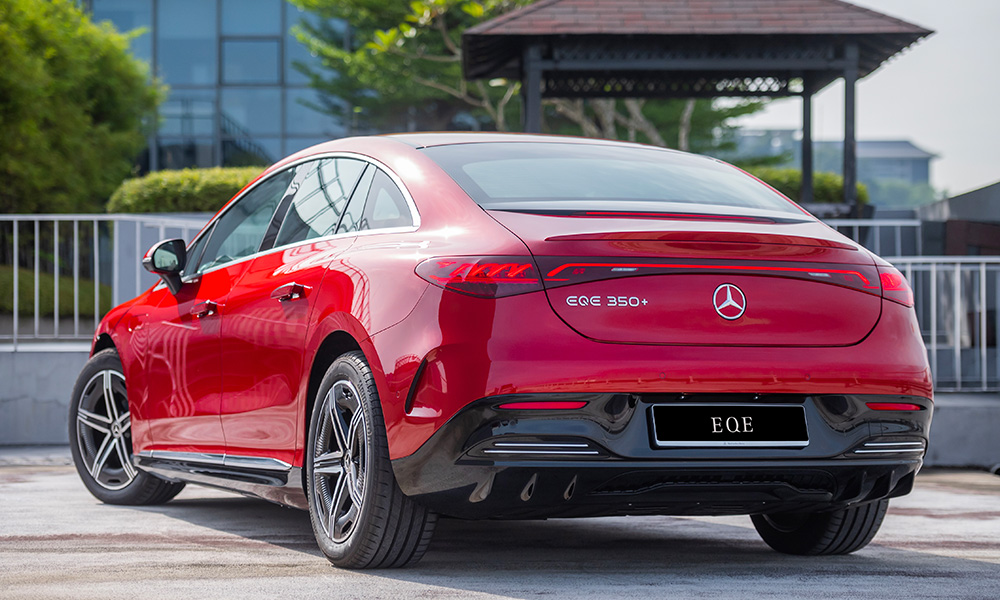
Already impressed? Then have a look at the financing
Get the most ideal finance and electrifying insurance solutions for the EQE, all from a single source. Designed with the customers in mind, Mercedes-Benz Financial tailored packages enables you to have regular fixed monthly instalments over a set period of time. Just choose a financing package that suits your need and we will take care of the rest. Perfectly tailored for the individual who seeks luxury, performance, value, unrivalled benefits and peace of mind at the wheel.
*Terms and conditions apply.
The new EQE at a glance:
| Model | EQE 350+ |
| Rated Output | 215 kW [292 hp] |
| Rated Torque | 565 Nm |
| Acceleration 0-100 km/h | 6.4 sec |
| Top speed | 210 km/h |
| HV battery – usable energy content | 90.56 kWh |
| Electr. Range (WLTP) | 587 – 669 km |
| AC charging time 10%-100% SOC (11kW) | 8hours 15 minutes |
| DC charging time 10%-80% SOC (170kW) | 32 min |
| Kerb weight/payload | 2.355 kg/525 kg |
| Recommended Retail Price (OTR w/o Insurance) with 10% Sales Tax | RM 419,888 |
